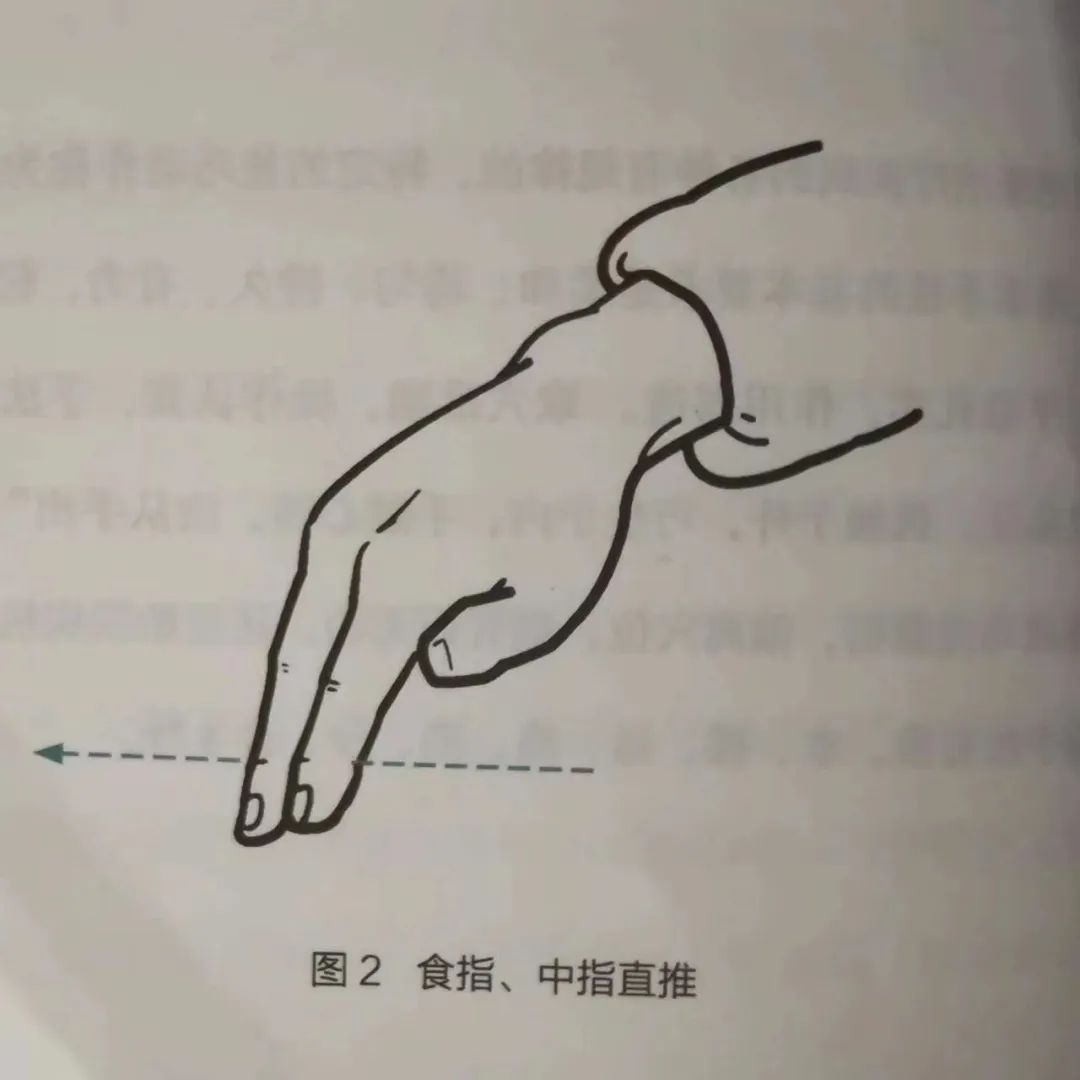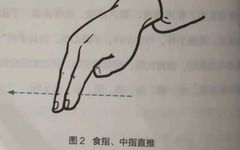
The various systematic and specific techniques used by practitioners to treat diseases are referred to as tuina shoufa (推拿手法, tuina techniques). The basic requirements for pediatric tuina techniques are that they should be gentle, even, sustained, and forceful, light yet not superficial, quick yet not chaotic, stable and solid, with deep penetration. Accurate point selection, careful operation, and skilled techniques are essential to achieve the principle of “once in clinical practice, the touch is external, the skill arises from within, the hands follow the heart, and the method comes from the hands.” Conversely, if the hands are unskilled or careless, deviating from the acupoints, the effort will be in vain, and it may even delay the condition. The commonly used techniques in pediatric tuina include tui (推, pushing), na (拿, grasping), rou (揉, kneading), yun (运, rolling), dao (捣, tapping), qia (掐, pinching), fen (分, separating), and he (合, joining).
 1. Tui Fa
1. Tui Fa
Using the radial side of the thumb or the textured surface of the index and middle fingers to perform a straight push on the acupoint is called tui fa (推法, pushing method) (Figure 2). The pushing should be directed forward in a straight line without deviation. The force should be gentle, even, and consistent, avoiding sudden changes in speed.

Within the pushing method, there are three variations: bu fa (补法, tonifying method), qing fa (清法, draining method), and qing bu fa (清补法, balancing method). The tonifying method pushes from the fingertip towards the base of the finger (centripetal for tonifying); the draining method pushes from the base of the finger towards the fingertip (centrifugal for draining); and the balancing method involves alternating pushes from fingertip to base (back and forth for balancing). This is a general rule, but there are exceptions, such as when pushing the Tian He Shui (天河水, Heavenly River Water) acupoint, where centripetal pushing is for draining. The speed of the pushing method should be about 200 times per minute. This method is often used on linear acupoints, such as Tian He Shui and Liufu (六腑, Six Fu organs).
Some acupoints can be pushed simultaneously (Figure 3), such as Ping Gan (平肝, Soothe the Liver) and Qing Fei (清肺, Clear the Lungs), where the middle finger is the heart acupoint and should not be pushed. The practitioner uses the left hand to separate, bringing the child’s index and ring fingers together and pushing them simultaneously.

2. Na Fa
Using the thumb and index finger to apply opposing pressure on a specific acupoint, alternating between tightening and loosening, is called na fa (拿法, grasping method) (Figure 4). This method is one of strong stimulation techniques and is often used in emergencies, for example, in the case of convulsions, applying pressure on the Lie Que (列缺, Broken Sequence) acupoint is one of the auxiliary techniques in pediatric tuina. For instance, after tuina, one can apply pressure on Wei Ling (威灵, Mighty Spirit) and Jing Ning (精宁, Essence Tranquility). The grasping method is generally used on point-like acupoints, and care should be taken to ensure appropriate tightness and gentle force.

3. Rou Fa
Using the thumb or the textured surfaces of the index and middle fingers to press on the acupoint and rotate left and right is called rou fa (揉法, kneading method) (Figure 5). The fingers should be firmly adhered to the acupoint, applying deep and substantial force, avoiding mere superficial friction. Left rotation promotes rising, while right rotation promotes descending; both should be performed the same number of times, approximately 200 times per minute. This method is often used on point-like acupoints, such as Er Ma (二马, Two Horses) and Wai Lao Gong (外劳宫, External Labor Palace).

4. Yun Fa
Using the thumb or the textured surfaces of the index and middle fingers together to perform arc-shaped or circular pushes on the acupoint is called yun fa (运法, rolling method) (Figure 6). The speed should be about 150-200 times per minute. This method is often used on face-like acupoints, such as Ba Gua (八卦, Eight Trigrams) and Yun Shui Ru Tu (运水入土, Water into Soil).

5. Dao Fa
Flexing the index and middle fingers and using the back of the finger joints to tap on the acupoint is called dao fa (捣法, tapping method) (Figure 7). This method is used on point-like acupoints, such as Xiao Tian Xin (小天心, Little Heavenly Heart).

6. Qia Fa
Using the nail of the thumb or other fingers to pinch the acupoint, creating a sensation of soreness and numbness is called qia fa (掐法, pinching method) (Figure 8). Care should be taken not to break the skin, such as pinching the five finger joints.

7. Fen Fa
Using both thumbs to push outward from a selected area is called fen fa (分法, separating method) (Figure 9), such as separating Yin and Yang.

8. He Fa
Using both thumbs to push inward from selected areas is called he fa (合法, joining method), such as joining Yin and Yang.
 Appendix: Nie Ji Fa
Appendix: Nie Ji Fa
When the child is lying face down, the practitioner uses the textured surface of the thumb to press against the skin, while the index and middle fingers press forward. The three fingers apply force simultaneously to pinch and grasp the skin, alternating hands to move forward, pushing, pinching, and lifting. Starting from the Chang Qiang (长强, Long Strong) acupoint, along the Du Mai (督脉, Governing Vessel) upwards to the Da Zhui (大椎, Great Vertebra) acupoint counts as one round. Each time, this should be done 3-5 rounds. To enhance stimulation, starting from the second round, for every three pinches, one lift should be performed, known as the “pinch three, lift one” method. Finally, use both thumbs to knead the Pi (脾, Spleen), Wei (胃, Stomach), and Shen Yu (肾俞, Kidney Shu) areas to improve efficacy (Figure 10).


Contributed by: Department of Traditional Chinese Medicine, Peng Hongxiao
Edited by: Publicity Department
Reviewed by: Zhang Yonggang


